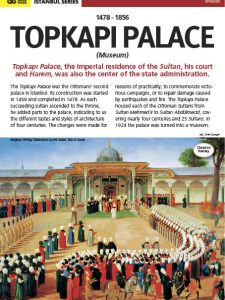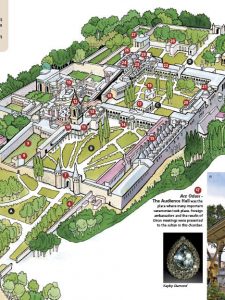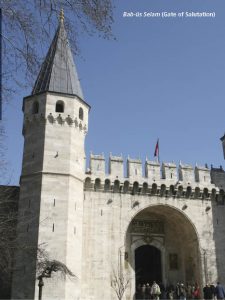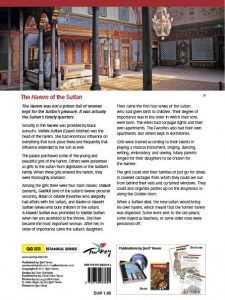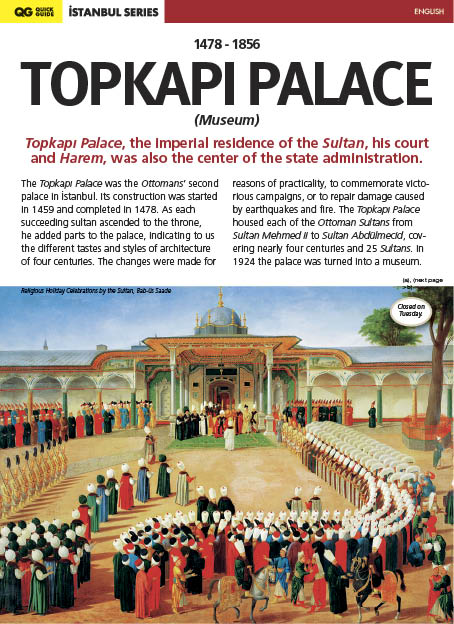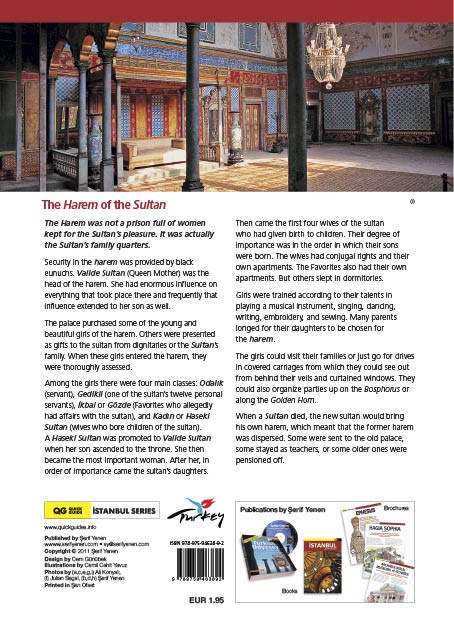Topkapi Palace
Topkapi Palace, located in Istanbul, Turkey, is a historic and iconic palace that served as the primary residence for Ottoman sultans for around 400 years. It features a blend of architectural styles and encompasses a vast complex of buildings, courtyards, and gardens.
Topkapı Palace Pamplet
A user friendly and informative Pamphlet with illustrations and plans. Its content is very easy to understand. In addition to general information about the Topkapi Palace Museum in Istanbul, Turkey, it shows the photos of all of the major monuments in and around the palace (Topkapi Sarayi). A general plan of the surrounding areas will help the reader to get oriented to the Sultanahmet neighborhood.
ISBN: 978-975-94638-9-2 Quick Guide Topkapı Palace (English, Turkish, German, French, Spanish, Italian, Portuguese, Greek, Arabic)
Available at Museum Shops in Turkey
Features of Topkapi Palace
Some of the notable features of Topkapi Palace include:
- Architectural Diversity: The palace is a reflection of various architectural styles, representing the evolution of Ottoman architecture over centuries. It features elements of Byzantine, Persian, and Islamic architecture.
- Courtyards: The palace is organized around four main courtyards: the First Courtyard (Gate of Salutation), the Second Courtyard (Divan Square), the Third Courtyard (Courtyard of the Sultan’s Mother), and the Fourth Courtyard (Private Garden).
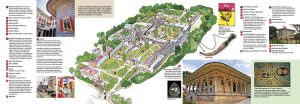 Gate of Salutation (Bab-ı Selam): The main entrance to the palace, where visitors would pay their respects to the sultan. It leads to the First Courtyard.
Gate of Salutation (Bab-ı Selam): The main entrance to the palace, where visitors would pay their respects to the sultan. It leads to the First Courtyard.- Imperial Council Hall (Divan Square): This area was used for official ceremonies, meetings, and receptions. It includes the Imperial Council Hall (Divan-i Hümayun) and the Audience Chamber (Arz Odası).
- Harem: The Harem was the private quarters of the sultan, his family, and concubines. It consists of various rooms and apartments, including the Sultan’s Mother’s Apartments, Queen Mother’s Apartments, and the Courtyard of the Eunuchs.
- Treasury (Kasr-ı Hümayun): The palace housed an extensive treasury that contained valuable items, including precious gemstones, jewelry, and artifacts.
- Palace Kitchens: The palace had a large kitchen complex capable of catering to the needs of the entire palace staff and inhabitants.
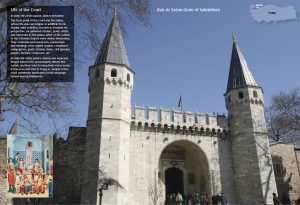 Imperial Gardens: The Fourth Courtyard featured beautiful gardens with various plant species and fountains. It offered a serene space for relaxation.
Imperial Gardens: The Fourth Courtyard featured beautiful gardens with various plant species and fountains. It offered a serene space for relaxation.- Tower of Justice (Adalet Kulesi): A prominent tower within the palace complex where the sultan could observe the city and receive petitions from his subjects.
- Tulip Garden (Lale Bahçesi): An area adorned with tulips and other flowers, reflecting the Ottoman love for horticulture.
- Gate of Felicity (Bab-üs Saade): The entrance to the Third Courtyard, where the sultan’s private apartments were located.
- Enderun School: A school within the palace complex that provided education and training for young boys who would potentially serve in the palace administration.
- Mosques: The palace complex includes several mosques, including the Hagia Irene Church, which was converted into a mosque, and the Imperial Mosque (Külliye-i Şahane Camii).
- Views of the Bosphorus: The palace’s strategic location on a hill overlooking the Bosphorus Strait provided stunning panoramic views of the waterway and the city.
- Museum: Today, Topkapi Palace operates as a museum, showcasing a wide range of artifacts, including Ottoman imperial regalia, religious relics, manuscripts, and more.
Topkapi Palace offers a glimpse into the opulent lifestyle of the Ottoman rulers and their intricate administrative, cultural, and social practices. Its architecture and historical significance make it a popular tourist attraction and a UNESCO World Heritage site.


